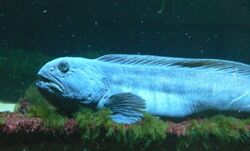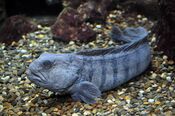Biology:Anarhichadidae
| Anarhichadidae | |
|---|---|

| |
| Northern wolffish, Anarhichas denticulatus | |
| Scientific classification | |
| Domain: | Eukaryota |
| Kingdom: | Animalia |
| Phylum: | Chordata |
| Class: | Actinopterygii |
| Order: | Scorpaeniformes |
| Suborder: | Zoarcoidei |
| Family: | Anarhichadidae Bonaparte, 1832 [1] |
| Genera[2] | |
|
See text | |
Anarhichadidae, the wolffishes, sea wolves or wolf eels, is a family of marine ray finned fishes belonging to the order Scorpaeniformes. These are predatory, eel shaped fishes which are native to the cold waters of the Arctic, North Pacific and North Atlantic Oceans.
Taxonomy
Anarhichadidae was first proposed as a family in 1832 by the French zoologist Charles Lucien Bonaparte.[1] The 5th edition of Fishes of the World classifies this family within the suborder Zoarcoidei, within the order Scorpaeniformes.[3] Other authorities classify this family in the infraorder Zoarcales wihin the suborder Cottoidei of the Perciformes because removing the Scorpaeniformes from the Perciformes renders that taxon non monophyletic.[4]
Etymology
Anarhichadidae is derived from the name of its type genus Anarhichas which is an Ancient Greek name for the Atlantic wolffish (A. lupus) and means "the climber", in turn derived from the Greek anarrhichesis which means "to climb or scramble up". This may be an allusion to the ancient belief that wolffishes left the water and climbed up on the rocks.[5]
Genera and species
Anarhichadidae contains two genera and five species:[2][6]
| Image | Genus | Living species |
|---|---|---|
 |
Anarhichas Linnaeus, 1758 |
|
 |
Anarrhichthys Ayres, 1855 |
|
Timeline of genera
<timeline> ImageSize = width:1000px height:auto barincrement:15px PlotArea = left:10px bottom:50px top:10px right:10px
Period = from:-65.5 till:10 TimeAxis = orientation:horizontal ScaleMajor = unit:year increment:5 start:-65.5 ScaleMinor = unit:year increment:1 start:-65.5 TimeAxis = orientation:hor AlignBars = justify
Colors =
#legends id:CAR value:claret id:ANK value:rgb(0.4,0.3,0.196) id:HER value:teal id:HAD value:green id:OMN value:blue id:black value:black id:white value:white id:cenozoic value:rgb(0.54,0.54,0.258) id:paleogene value:rgb(0.99,0.6,0.32) id:paleocene value:rgb(0.99,0.65,0.37) id:eocene value:rgb(0.99,0.71,0.42) id:oligocene value:rgb(0.99,0.75,0.48) id:neogene value:rgb(0.999999,0.9,0.1) id:miocene value:rgb(0.999999,0.999999,0) id:pliocene value:rgb(0.97,0.98,0.68) id:quaternary value:rgb(0.98,0.98,0.5) id:pleistocene value:rgb(0.999999,0.95,0.68) id:holocene value:rgb(0.999,0.95,0.88)
BarData=
bar:eratop bar:space bar:periodtop bar:space bar:NAM1 bar:NAM2
bar:space bar:period bar:space bar:era
PlotData=
align:center textcolor:black fontsize:M mark:(line,black) width:25 shift:(7,-4) bar:periodtop from: -65.5 till: -55.8 color:paleocene text:Paleocene from: -55.8 till: -33.9 color:eocene text:Eocene from: -33.9 till: -23.03 color:oligocene text:Oligocene from: -23.03 till: -5.332 color:miocene text:Miocene from: -5.332 till: -2.588 color:pliocene text:Plio. from: -2.588 till: -0.0117 color:pleistocene text:Pleist. from: -0.0117 till: 0 color:holocene text:H.
bar:eratop from: -65.5 till: -23.03 color:paleogene text:Paleogene from: -23.03 till: -2.588 color:neogene text:Neogene from: -2.588 till: 0 color:quaternary text:Q.
PlotData=
align:left fontsize:M mark:(line,white) width:5 anchor:till align:left
color:pliocene bar:NAM1 from: -5.332 till: 0 text: Anarhichas color:pleistocene bar:NAM2 from: -2.588 till: 0 text: Anarrhichthys
PlotData=
align:center textcolor:black fontsize:M mark:(line,black) width:25
bar:period from: -65.5 till: -55.8 color:paleocene text:Paleocene from: -55.8 till: -33.9 color:eocene text:Eocene from: -33.9 till: -23.03 color:oligocene text:Oligocene from: -23.03 till: -5.332 color:miocene text:Miocene from: -5.332 till: -2.588 color:pliocene text:Plio. from: -2.588 till: -0.0117 color:pleistocene text:Pleist. from: -0.0117 till: 0 color:holocene text:H.
bar:era from: -65.5 till: -23.03 color:paleogene text:Paleogene from: -23.03 till: -2.588 color:neogene text:Neogene from: -2.588 till: 0 color:quaternary text:Q.
</timeline>
Characteristics
Anarhichadidae wolfishes have a largely compressed and, in the genus Anarhichas, a moderately elongate body. Anarrhichthys has an extremely elongate body, and this has given rise to its common name of wolf-eel. The long dorsal fin starts at the head and has many flexible spines and soft rays. The anal fin may have a single spine in Anarrhichthys, and again there is a large number of soft rays. The caudal fin is separate from the other median fins in Anarhichas but they are all three joined in Anarrhichthys. There is a single pair of nostrils. The scales, if present, are cycloid, tiny and do not overlap. There are well developed. movement sensitive sensory canals on the head and as the fish ages the pores grow very large. There are 1 or 2 lateral lines made up of superficial neuromasts.[2] There are robust conical teeth in the front of the jaws and large molar like teeth to the rear of those.[3] The gill membranes are joined to the isthmus and the gill openings are set widely apart. There is no swim bladder. The counts of vertebrae are 72–89 in Anarhichas and 221–251 in Anarrhichthys.[7] The longest published total length is for Anarrhichthys ocellatus and is 240 cm (94 in).[2]
Distribution and habitat
Anarhichadidae wolfishes prefer cooler waters and are found in the northern parts of the North Pacific and North Atlantic Oceans as well as in the Arctic Ocean.[3] They are demersal fishes occurring in shallow to moderately deep and cold seas.[2]
Biology
Anarhichadidae wolffishes use their large teeth to feed on a diet of shelled invertebrates such as crabs, starfishes and sea urchins, as well as other prey,[8] The peak mating season for wolffish is September to October. The male wolffish will guard the eggs 3–9 months until they hatch.[9]
Fisheries
Anarhichadidae wolffishes, in particular two Atlantic species, the spotted wolffish and the Atlantic wolffish, are targeted by commercial fisheries. The flesh is used for food and the skin to make leather.[7]
References
- ↑ 1.0 1.1 Richard van der Laan; William N. Eschmeyer; Ronald Fricke (2014). "Family-group names of Recent fishes". Zootaxa 3882 (2): 001–230. doi:10.11646/zootaxa.3882.1.1. PMID 25543675. https://www.researchgate.net/publication/268078514.
- ↑ 2.0 2.1 2.2 2.3 2.4 Froese, Rainer, and Daniel Pauly, eds. (2022). "Anarhichadidae" in FishBase. February 2022 version.
- ↑ 3.0 3.1 3.2 J. S. Nelson; T. C. Grande; M. V. H. Wilson (2016). Fishes of the World (5th ed.). Wiley. pp. 478–482. ISBN 978-1-118-34233-6. https://sites.google.com/site/fotw5th/. Retrieved 2022-07-24.
- ↑ Ricardo Betancur-R; Edward O. Wiley; Gloria Arratia et al. (2017). "Phylogenetic classification of bony fishes". BMC Evolutionary Biology 17 (162): 162. doi:10.1186/s12862-017-0958-3. PMID 28683774.
- ↑ Christopher Scharpf; Kenneth J. Lazara, eds (4 July 2021). "Order Perciformes (Part 11): Suborder Cottoidea: Infraorder Zoarcales: Families: Anarhichadidae, Neozoarcidae, Eulophias, Stichaeidae, Lumpenidae, Ophistocentridae, Pholidae, Ptilichthyidae, Zaproridae, Cryptacanthodidae, Cebidichthyidae, Scytalinidae and Bathymasteridae". The ETYFish Project Fish Name Etymology Database. Christopher Scharpf and Kenneth J. Lazara. http://etyfish.org/perciformes15/.
- ↑ Eschmeyer, William N.; Fricke, Ron; van der Laan, Richard, eds. "Genera in the family Anarhichadidae". California Academy of Sciences. http://researcharchive.calacademy.org/research/ichthyology/catalog/fishcatget.asp?tbl=genus&family=Anarhichadidae.
- ↑ 7.0 7.1 Catherine W. Mecklenburg (2003). "Family Anarhichadidae Bonaparte 1846 wolffishes". Annotated Checklist of Fishes (California Academy of Sciences) (10). ISSN 1545-150X. https://www.calacademy.org/sites/default/files/assets/docs/anarhichadidae.pdf.
- ↑ "Wolffish". Encyclopedia Britannica. https://www.britannica.com/animal/wolffish.
- ↑ "Fisheries, NOAA. "Atlantic Wolffish." NOAA". 2 December 2020. https://www.fisheries.noaa.gov/species/atlantic-wolffish.
- "Anarhichadidae". Integrated Taxonomic Information System. https://www.itis.gov/servlet/SingleRpt/SingleRpt?search_topic=TSN&search_value=171335. Retrieved 5 December 2004.
- Sepkoski, Jack (2002). "A compendium of fossil marine animal genera". Bulletins of American Paleontology 364: 560. http://strata.ummp.lsa.umich.edu/jack/showgenera.php?taxon=611&rank=class. Retrieved 2011-05-18.
- “The Wolffishes (Family : Anarhichadidae).” Finfish Aquaculture Diversification, by R. Le François Nathalie, CABI, 2010, pp. 417–418.
Wikidata ☰ Q604663 entry
 |

